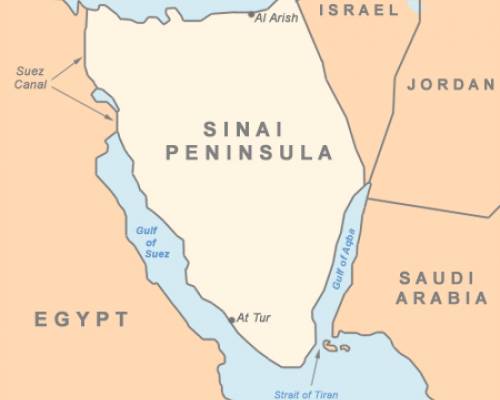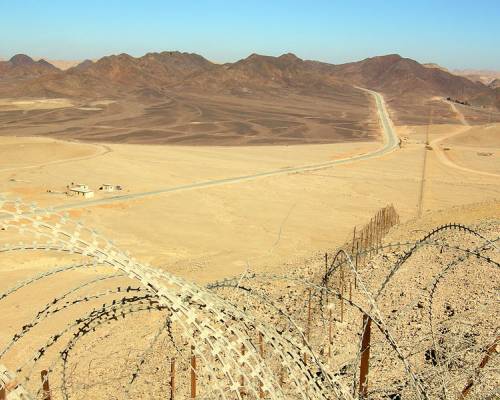Threats in the Sinai Peninsula
What really are the threats in the Sinai Peninsula? RPS Partnership's intelligence analyst gives us his views on what sort of threat the Bedouins and Ismalists really are, in the light of the attacks which have taken place this week.
Situated on the cusp of the African and Asian continents, the Sinai Peninsula is the start of the true ‘Middle East’ and as such plays host to many of the conflicts found therein. Geographically, the Peninsula is desolate and arid, with vast swathes of rocky terrain making it difficult to navigate – and making it a perfect haven for extremism and crime.
Whilst ostensibly part of Egypt, in reality the government has almost no political control over the inhabitants and is forced to rely on ever-increasing military incursions which, in turn, lead only to bigger backlashes directed at the security forces.
There are two main threat groups in the Sinai Peninsula: Bedouin militants and Islamist extremists.
The Bedouin
Firstly it should be stated that by no means is the entire Bedouin tribal community named as a threat group, but there are sufficient enough numbers within the tribes who have taken up arms to warrant concern. The primary concern of the tribes is that the Egyptian government has done nothing to ease the difficulty with which they conduct their lives in the Peninsula – Sinai has been treated not as part of a ‘new Egypt’, but only as a resource to be exploited.
Witness the only true infrastructure development in the region being the Arab Gas Pipeline rather than social infrastructure that would improve the Bedouin’s quality of living in what is, as has been stated, extremely difficult conditions. Furthermore, the tribes claim to face discrimination when seeking employment and allege that tribal land rights are being systematically ignored by a government encroaching into the Sinai for purposes of its own.
These grievances have built to a situation where certain numbers among the tribesmen have launched a violent campaign to strike back at the security forces by any means necessary. The backbone of these efforts is a dedication to attacking the apparatus of ‘the state’ within Sinai – not only attempting to destroy police stations found in her myriad towns but targeting Egyptian military personnel with intent to kill. This is accomplished either by assaulting patrols directly or by IEDs concealed in vehicles.
On occasion, they have targeted Western individuals for Kidnap & Ransom (most notably the regional head of Exxon, Andrew Wells, earlier this year) but crucially these assaults happen deep inside the Sinai borders, and only appear to be opportunistic. The military present a far larger and more tantalising prospect.
The Bedouin have also shown a tendency to attack Egyptian infrastructure, as evidenced by the frequent bomb attacks against unguarded sections of the pipeline that runs along Sinai’s north and eastern edges. One of the successes of their operations has been the weapons network they are able to run, with arms coming in from neighbouring conflicts in Libya, Gaza, Lebanon and Syria.
These networks are undoubtedly the source of the Stinger missiles known to be fired against helicopters and armoured military vehicles, and potentially allow the Bedouin to prolong the conflict indefinitely – assuredly the military will keep coming, but if the Bedouin can meet them on their own terms, they will have an endless array of targets within Sinai where it is they, and not the government, who have the upper hand.
What the Bedouin have shown no signs of doing, thus far, is attacking beyond Sinai’s borders.
Whilst the ongoing uprisings in Cairo are of interest, changing as they may the government that claims to rule over the Bedouin, their intrinsic links to the Peninsula would arguably mean that, should the tribes ever attack the mainland, the perception of them as some kind of ‘freedom fighters’ inside their homeland may change to more conventional ‘terrorists’, and simply cause the military to strike back even harder.
Also, the Bedouin have no reason to attack outside of the Peninsula. They have not shown themselves to be interested in mass loss of human life in their attacks, but are extremely focused in their MO of attacking military and security targets.
Why make the effort to travel out of Sinai to strike Westerners when they have a ready-made target list of hard and soft military targets coming directly to them – targets that they have an expressed grievance against, something that cannot be said of the relationship between Bedouin and Western tourists. If the entire campaign is predicated against the military, to travel further for an attack not related to the military whatsoever is not tactical sense.
Inside Sinai, the Bedouin can win because they have control, of territory, weapon networks and force of numbers; and this is what their entire campaign is built on. One step out of Sinai and they lose that control – a mistake that is not worth the effort.
Islamists
Al-Qaeda and associated Salafist movements began to enter Sinai in force from 2011 onwards, attracted by the political instability of the mother government and looking to take advantage of the power vacuum that had now deepened in Sinai.
These fighters came mostly from al-Qaeda’s branches in the Arabian Peninsula and the Islamic Maghreb, and brought with them the extensive AQ network of contacts, suppliers and supporters. They found an uneasy ally in the Bedouin – whilst few tribesmen adhered to al-Qaeda ideologically, any opposition to the Egyptian government was welcomed, and the two began to share their equipment and networks.
The Islamists have shown themselves keener than the Bedouin to attack Western targets – a consequence of motivation and ideology – but again, their Egyptian activity has been confined to the Peninsula and not to the mainland itself.
As evidenced by the Sharm-el-Sheikh and Dahab bombings in 2005-06, militants had been in the Peninsula for years but it was not until 2011 that they began to arrive in numbers – now estimated at around 3500. And while such attacks were atrocities, they are very much the exception rather than the norm. As with the Bedouin, the Islamists have concentrated their attacks on the military and security personnel, perhaps cognisant that if they can all but eradicate Egyptian hard authority in the Peninsula, they can then use it as another Middle Eastern base, similar to Yemen, from which to plan and launch wider attacks.
The equipment of the militants is much the same as that used by the Bedouin, a consequence perhaps of merging their trade networks. Improvised explosives are commonly used to strike Sinai pipelines – fifteen such attacks have occurred since 2011 – and make frequent use of large numbers of machine guns and RPGs in their attacks.
The deadliest strikes so far occurred on 5 August 2012, when thirty-five militants attacked an Egyptian army base at the western edge of the Peninsula, killing sixteen soldiers, before attempting to flee through an Israeli border crossing; and on August 19 2013 twenty-five new police recruits were executed on the Rafah-El Arish road after their bus was held at gunpoint.
The attack on September 16 2013, when a roadside IED overturned a police bus and one escapee was captured and shot (the only casualty) – continues the almost exclusive trend of attacking the police and military, preferably personnel, as do the attacks this week.
A hundred soldiers have died in the past year alone and numerous transports and facilities have been bombed. But while the extremists may be more bloodthirsty than the Bedouin, they are equally unwilling (or unable) to extend this pattern of attacks across to the Egyptian mainland.
This is as much due to capability as it is to intent. With the security forces in Egyptian cities exerting a crackdown and curfew with extreme force, there is so little opportunity for Salafists to gain a foothold in the current climate that the cost appears not to be worth it, and the same can be said for any installation or major tourist venue.
Security is so increased, whether by private or government design, that terrorist attacks have a much reduced chance of success. Besides, as with the Bedouin, Islamists have no reason to venture beyond Sinai. It is on the Peninsula that their gains will be proven, and on the Peninsula that the greatest targets present themselves.
Summary
If we have learnt anything of al-Qaeda over the past ten years it is of the organisation’s capability to adapt and make best use of whatever situation it finds itself in – and so there is no reason to assume that their Egyptian cells will be concentrating on anywhere other than the Sinai Peninsula.
Photos: rwarrior.com and algeminer.com



